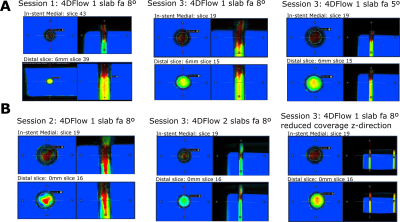Ana Beatriz Solana1, Margarita Gorodezky2, Ann Shimakawa3, Peng Lai3, and Christian Meierhofer4,5
1GE Healthcare, Munich, Germany, 2GE Healthcare, London, United Kingdom, 3GE Healthcare, Sunnyvale, CA, United States, 4German Heart Center Munich, Munich, Germany, 5TUM, Munich, Germany
1GE Healthcare, Munich, Germany, 2GE Healthcare, London, United Kingdom, 3GE Healthcare, Sunnyvale, CA, United States, 4German Heart Center Munich, Munich, Germany, 5TUM, Munich, Germany
Accurate in-stent
net flow measurements were only possible for platinum-iridium. There, 2D
measurements were accurate and reproducible while 4DFlow showed underestimation
for large volume coverage schemes when this stent was at the end of the outflow
tube.

Figure 1: Coronal
view from the U-shaped flow phantom before the stent positioning for session 1,2
and 3 including the position of the 4 stents evaluated in this work. Fluid flew
from right to left for session 1 and session 3 while it flew left to right for
session 2. 45/21 slice, respectively, were acquired for 2D PC CINE for session
1 and session 2-3, 1 slab whole volume 4DFlow with flip angle 8º and
acceleration 8 was acquired in the 3 sessions and session 3 acquired additional
4DFlow acquisition with different parameters and coverage.
